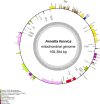Reproductive and persistence strategy of the liverwort Arnellia fennica after the last glaciation in the area of disjunction in Central Europe (Polish Tatra Mountains, carpathians)
- PMID: 39814918
- PMCID: PMC11735928
- DOI: 10.1038/s41598-025-85757-x
Reproductive and persistence strategy of the liverwort Arnellia fennica after the last glaciation in the area of disjunction in Central Europe (Polish Tatra Mountains, carpathians)
Abstract
The liverwort Arnellia fennica has a circumarctic distribution with disjunct and scarce localities in the Alps, Carpathians, and Pyrenees. Within the Carpathians, it is only known from the Tatra Mountains (in Poland), where so far only four occurrences have been documented in the forest belt of the limestone part of the Western Tatras. The species is considered a tertiary relict, which owes its survival during the last glaciation period to low-lying locations in areas not covered by ice. Previously, it has been demonstrated that this plant does not produce gemmae in the Tatra Mountains, nor does it reproduce sexually, hence it has not spread in this massif despite the high availability of potential habitats. These studies address the following questions: (1) why A. fennica, an arctic-alpine species, has only been found at low elevations in the Tatra Mountains so far, (2) what were the possibilities of its survival during the glaciation period as verified based on the latest paleoglaciological map, (3) how this species persists in the Tatras and why it remains a rare plant. As a result, nine additional new occurrences were found, bringing the total to 13 throughout the massif. Some of the sites were found in the high mountain area. For the first time, the production of gemmae in the Tatra population of A. fennica was observed and documented, along with the presence of male specimens of this dioecious species. Genetic studies have shown that individuals from all three groups of sites are genetically homogeneous, indicating a lack of sexual reproduction. The only way of dispersal for A. fennica in the Tatras is through propagule production. The uniqueness and specificity of these structures have been described, which differ significantly from the common model known in liverworts. The rarity of the species in the Tatra massif is attributed to the inefficient mode of vegetative reproduction and the absence of sexual reproduction. Paleoglaciological analysis of all montane sites (historical and new) of A. fennica showed that half were located in areas covered by glaciers. The hypothesis of this liverwort's survival during the glaciation period, at lower elevations, should be rejected. In light of the new data obtained, montane localities should be considered as secondary, which could have arisen after the glacier retreated only from high-mountain populations producing propagules transported downhill.
Keywords: Endangered species; Genetic variation; Limestone flora; Organellar genomes; Tertiary relicts.
© 2025. The Author(s).
Conflict of interest statement
Declarations. Competing interests: The authors declare no competing interests.
Figures











Similar articles
-
[Studies in the fauna of waters in the Polish part of the Tatra Mountains in the years 1919-1939].Kwart Hist Nauki Tech. 2015;60(3):67-77. Kwart Hist Nauki Tech. 2015. PMID: 29943564 Polish.
-
The genetic structure of the mountain forest butterfly Erebia euryale unravels the late Pleistocene and postglacial history of the mountain coniferous forest biome in Europe.Mol Ecol. 2008 May;17(9):2194-207. doi: 10.1111/j.1365-294X.2007.03687.x. Epub 2008 Feb 5. Mol Ecol. 2008. PMID: 18266631
-
New international long-term ecological research on air pollution effects on the Carpathian Mountain forests, Central Europe.Environ Int. 2003 Jun;29(2-3):367-76. doi: 10.1016/S0160-4120(02)00172-1. Environ Int. 2003. PMID: 12676229 Review.
-
High genetic differentiation in the alpine plant Campanula alpina Jacq. (Campanulaceae): evidence for glacial survival in several Carpathian regions and long-term isolation between the Carpathians and the Alps.Mol Ecol. 2008 Apr;17(7):1763-75. doi: 10.1111/j.1365-294X.2008.03664.x. Epub 2008 Feb 14. Mol Ecol. 2008. PMID: 18284572
-
The Role of the Hercynian Mountains of Central Europe in Shaping Plant Migration Patterns in the Pleistocene-A Review.Plants (Basel). 2023 Sep 20;12(18):3317. doi: 10.3390/plants12183317. Plants (Basel). 2023. PMID: 37765481 Free PMC article. Review.
References
-
- Schuster, R. M. The Hepaticae and Anthocerotae of North America. Vol. IV. (Columbia University Press, New York, 1980).
-
- Crandall-Stotler, B. J., Stotler, R. E. & Long, D. G. Phylogeny and classification of the Marchantiophyta. Edinb. J. Bot.66(1), 155–198. 10.1017/S0960428609005393 (2009).
-
- Váňa, J., Grolle, R. & Long, D. G. Taxonomic realignments and new records of Gongylanthus and Southbya (Marchantiophyta: Southbyaceae) from the Sino-Himalayan region. Nova Hedwigia95(1/2), 183–196. 10.1127/0029-5035/2012/0042 (2012).
-
- Shaw, B. et al. Phylogenetic relationships and Morphological Evolution in a Major Clade of Leafy Liverworts (Phylum Marchantiophyta, Order Jungermanniales): Suborder Jungermanniineae. Syst. Bot.40(1), 27–45. 10.1600/036364415X686314 (2015).
Publication types
MeSH terms
Grants and funding
LinkOut - more resources
Full Text Sources
Research Materials

